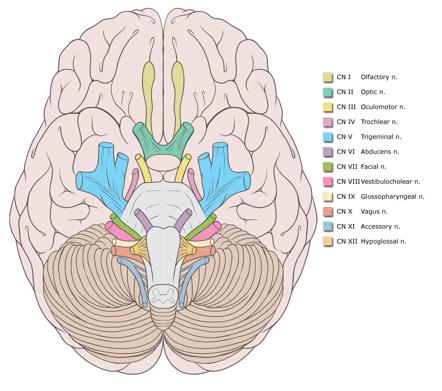Template:Nerves
Original Editor - Tarina van der Stockt
Top Contributors - Tarina van der Stockt, George Prudden and Evan Thomas
Description
[edit source]
There are 12 pairs of cranial nerves and they are numbered according to their position of where they originate on the inferior surface of the brain. The names of the cranial nerves (CN) are: CN I - olfactory, CN II - optic, CN III - oculomotor, CN IV - trochlear, CN V - trigeminal, CN VI - abducens, CN VII - fascial, CN VIII - vestibulocochlear, CN IX - glossopharyngeal, CN X - vagus, CN XI - accessory, and CN XII - hypoglossal. [1]
Function[edit source]
The names of the cranial nerves sometimes correspond with their individual function. The cranial nerves are comprised of axons that are either sensory, motor or both. [1]
| Cranial Nerve | Sensory Function | Somatic Motor Function | Autonomic (parasympathetic motor) Function |
|---|---|---|---|
| CN I - olfactory |
|||
| CN II - optic |
|||
| CN III - oculomotor |
|||
| CN IV - trochlear |
|||
| CN V - trigeminal |
|||
| CN VI - abducens |
|||
| CN VII - fascial |
|||
| CN VIII - vestibulocochlear |
|||
| CN IX - glossopharyngeal |
|||
| CN X - vagus |
|||
| CN XI - accessory |
|||
| CN XII - hypoglossal |







